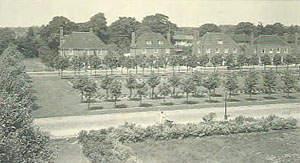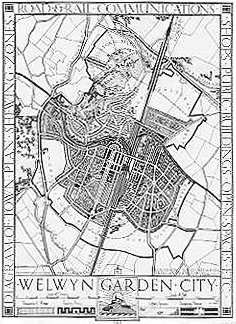Welwyn Garden City
 |
 |
Ebenezer Howard had two aims: to solve together the problems of the congested city and of the "undeveloped" countryside.
He thought that if you could mix the town and country together you'd get the benefits of both. He thought that the best size for a town or city was 32,000 people, with no more than 30 houses per hectare.
Central parkland was to be surrounded by housing with factories on the edges, all surrounded by a green belt. Sewage would be recycled back to the land. Towns would be independent, not satellites to other cities.
Welwyn Garden City, begun in 1919, ended up quite different from his original ideal for many reasons. Nevertheless the photograph shows that his central concept still held.
Now a city of over 100,000 people, it is a Garden City in form but not practice - unfortunately its agricultural belt never happened.
Howard's legacy
His ideas still have great influence today. He thought that the Garden City should be socially, economically and ecologically sustainable. For example land should be bought at low, agricultural values and all houses and factories should be leaseholds.
Investors would be paid back from the rent, and any increase in land values would benefit the whole community. Extra money from the rent could then finance pension funds and community services.
Examples of other towns influenced by Howard's work include Margarethenhohe, near Essen, Germany, built to houses steelworkers, Sunnyside Gardens near New York, Chatham village in Pittsburg and Radburn, New Jersey, although these ended up, like Hampstead Garden, another of Howard's projects, as suburbs.
--> Letchworth Garden City Greenway
--> Garden Cities
--> ecovillages
--> home
To commission work of this nature, contact David Thorpe.
back to About David
© David Thorpe 2006 All Rights Reserved
 A history of greenspace and parks
A history of greenspace and parks